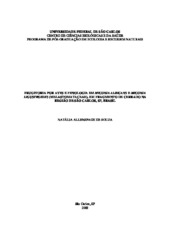Frugivoria por aves e fenologia em Miconia albicans e Miconia ligustroides (Melastomataceae), em fragmento de cerrado na região de São Carlos, SP, Brasil

Ver/
Fecha
2009-04-13Autor
Souza, Natália Allenspach de
Metadatos
Mostrar el registro completo del ítemResumen
The present study had as objective to characterize the avian guild that consumes Miconia albicans and Miconia ligustroides fruits and also to describe the fenology of these plants. The study was carried out in a 124.68 ha fragment of cerrado vegetation, located in the Universidade Federal de São Carlos, campus São Carlos (21°58´ S, 47° 52´ W), São Paulo state, Brazil. Between March 2008 and February 2009, 30 plants of each species, random selected, were accompanied every 2 weeks and the number of floral buds, flowers, fruits and the percentage of new leaves were registered. During the fruiting periods, 96 hours of focal tree observations were made for each vegetal species, when the visitant birds, time and duration of visits, number of consumed fruits and the treatment given to the fruits were registered. M. ligustroides fruits were given to captive birds, to assess retention time
of the seeds in their digestive tract. M. albicans fruited between October and January, coinciding with the wet season. During this period, 212 visits with fruit consumption were observed, performed by 19 bird species from 9 families. Species of the family Emberizidae were responsible for the majority of visits (34.9%), but the treatment given to the fruits allows to infer they are probable seed predators. Mimus saturninus and Patagioenas picazuro consumed the largest parcel of fruits (respectively 23.34 and 19.27%). M. ligustroides fruited between March and June, in the transition between wet and dry seasons. 101 visits performed by 15 bird species from 6 families were observed. Species of genera
Elaenia performed the majority of visits (34.65%), followed by Tangara cayana (12.87%) and Schistochlamys ruficapillus (10.89%). Family Thraupidae species were, together, the
most representative in number of visits and fruit consumption. Average duration of visits for each bird species was always less than 3 minutes, lower even than the smallest retention
time observed at the captive birds experiment (Pitangus sulphuratus: 4.98 ± 1.53 minutes). Adding the fact that birds consumed the whole fruit in all observations made at M.
ligustroides trees, it is posible that the observed birds are potential seed dispersers of this plant. M. albicans and M. ligustroides produce a large amount of small fruits with many
diminute seeds. Their fruits are consumed by many bird species with generalist diets. Therefore, both elastomataceas utilize an opportunistic frugivore bird dispersion strategy.
These data show that both species may be usefull in conservation programs for recuperation of degraded cerrado areas, but future studies are necessary to verify the dispersive potential of the birds here registered, just as to know the germination and seedling establishment characteristics.